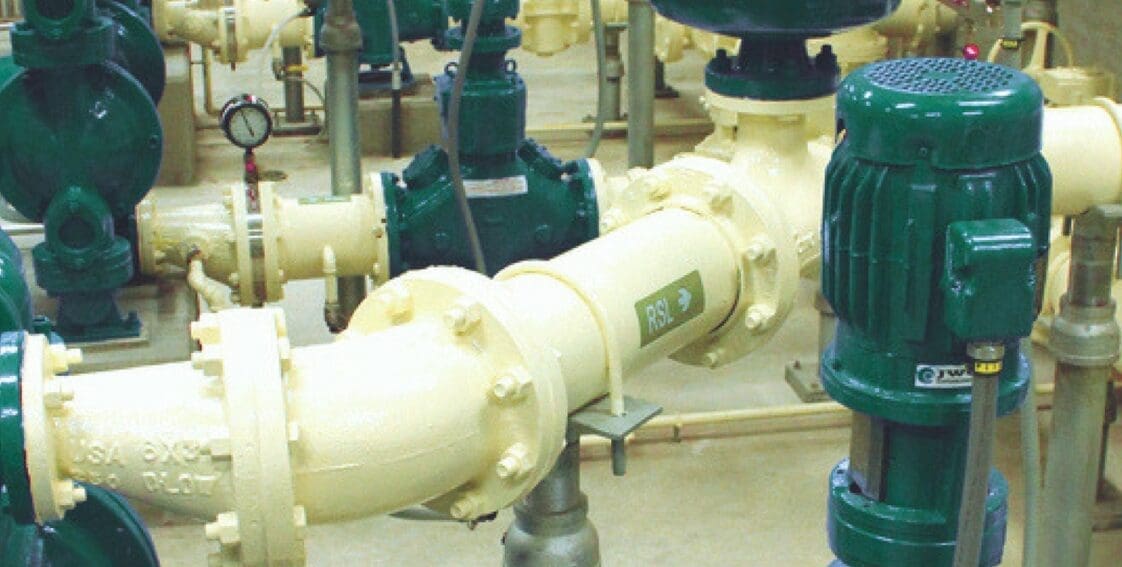
Technology Tips – Grinders for Sewage Sludge Systems
Q&A on Sewage Sludge Grinders
Ever since the development of activated sludge processes in the early 20th century, wastewater engineers have had to contend with debris getting into them. Unwanted materials cause pump clogging, fouling of thickening technologies like centrifuges, and potential damage to a variety of critical treatment equipment. To combat this, engineers began to deploy reduction and removal equipment into sludge systems, including additional screening and single shaft comminutors. In the early 1970s, the two-shafted grinder was introduced to the market and has been a fixture in wastewater treatment plant sludge systems ever since. The slow speed but extremely high torque operation of a two-shafted grinder proved itself as a reliable solution to shred the toughest solids and make the life of a wastewater operator much easier. The industry has seen significant changes since the 1970s but the need for grinders has persisted and evolved. JWC Environmental started offering two-shafted grinding more than 45 years ago with its Muffin Monster grinders. Kevin Bates, their director of product management and marketing, was recently asked several questions about the use of grinder technology in the wastewater industry.
Why were grinders first used with a treatment plant’s sewage sludge system?
The number one reason grinders have become a staple in treatment plants around the world is their ability to protect sludge pumping equipment. Due to the viscous nature of sewage sludge, there are a variety of pumping technologies that are typically employed to move thickened materials. Some of these, like progressive cavity and rotary lobe pumps, rely on elements with very close tolerances. These pumps can easily be damaged by harder debris, and fouled by rags or other stringy materials. Grinders are used to simply shred the materials small enough, so that the pumps can do their job efficiently.
What has changed with how grinders are used in sewage sludge systems?
While protecting pumps still remains the top application’s, the sophistication of biosolids processing in treatment plants has evolved significantly over the last 45 years. This has exposed new areas where grinders are needed to help overall plant efficiency. They are routinely used to protect centrifuges and heat exchangers from debris that can put them out of commission. The cost of a grinder is very small, compared to a significant repair on a centrifuge.
With the increase in primary treatment, especially headworks fine screening, isn’t there less debris in sewage sludge today?
Some of the largest items that would have historically been found in a plant’s treatment systems are now pulled out at the headworks. That said, smaller debris still makes its way into a plant and into digestion systems. This can include hair, smaller wipes materials, and other inorganics. Additionally, there are secondary sources like trucked-in septage or sludge from other facilities that can introduce additional trash. This small debris can come together in digesters and form hair balls, wipes ropes and other tougher solid masses. When sludge is drawn off the bottom of digesters or through a recirculation loop, the solids will quickly shut down pumps.
What has changed in sludge grinder technology?
One new advancement from JWC Environmental has been its Wipes Ready technology for Muffin Monster two-shafted grinders. This technology includes new serrated cutters which are specifically designed to handle disposable wipes. The Wipes Ready cutter first saw success in protecting lift station pumps within collection system networks where the wipes problems are the worst. More recently treatment plants have been using the technology for their inline Muffin Monster sludge grinders. Users are reporting even better performance in cutting through rags and hair within recirculation loops and waste activated sludge pipelines.
Are there any important design considerations in two-shafted grinders?
Rugged construction and a history of reliable performance are paramount in selecting a two-shafted grinder. Like everything else in a treatment plant, they are working in a harsh and often hazardous environment. If a grinder needs frequent attention, it is not only burdening a plant’s maintenance staff, it is also exposing them unnecessarily to bio-waste and other hazards. There are various design concepts for two-shafted grinders on the market today that have real trade-offs engineers must consider. One is to only support the twin shafts at the top end of the grinder. This is done by eliminating the bottom bearings and seals and allowing the shaft ends to float in the pipeline. The concept of this approach is that by eliminating the bottom seals they don’t have to survive submerged in the sludge. This design without seals will of course lower the cost of the grinder. Unfortunately, with support at only one end, the two shafts are allowed to flex as solids pass through them which can lead to failure of the top seals and eventually the shafts. JWC’s Muffin Monsters always provide top and bottom tungsten carbide seals, which rigidly control the shafts to deal with the loading of tough solids and reversals.
What are the maintenance considerations for two-shafted grinders in sludge?
In general, the application’s of grinders within sludge systems is not extremely difficult compared to other areas in wastewater where they are used. This means that maintenance should only be an inspection to verify everything is working as intended. For in-pipeline type grinders used in sludge systems, the operator should be able to inspect the cutter condition while the cutter stack stays within grinder housing. This is achieved using inspection ports designed in the grinder housing. Operators can avoid the time and potential complexity of lifting the heavy cutter stack out of grinder housing. Ideally, inspections should only be required on an annual basis. There are some grinders which require lubrication oil changes every three months to protect the bearings or to clean out debris traps. Unfortunately, if frequent tasks like lubrication are required, they are often neglected, leading to premature failure of the grinder.
